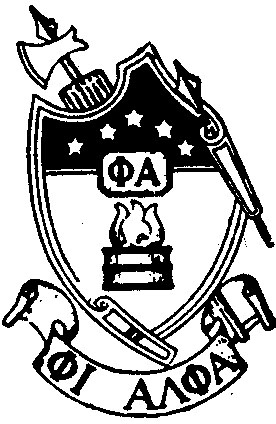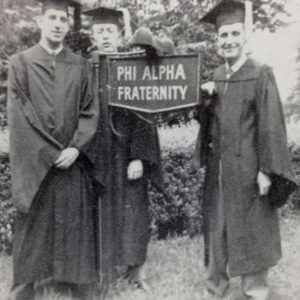Phi Alpha
 Phi Alpha was founded at George Washington University, Washington D.C., on October 14, 1914 by David Davis, Edward Lewis, Hyman Shapiro, Reuben Schmidt and Maurice Herzmark, who saw the need for an idealistic brotherhood. The first pledge ceremony in February, 1915, was followed by the establishment of a chapter house, one of the most luxurious establishments in the nation’s capital. Thus Phi Alpha was born.
Phi Alpha was founded at George Washington University, Washington D.C., on October 14, 1914 by David Davis, Edward Lewis, Hyman Shapiro, Reuben Schmidt and Maurice Herzmark, who saw the need for an idealistic brotherhood. The first pledge ceremony in February, 1915, was followed by the establishment of a chapter house, one of the most luxurious establishments in the nation’s capital. Thus Phi Alpha was born.
Dr. Edward Cafritz (Alpha), transferred to the University of Maryland in Baltimore and there spread the ideals of Phi Alpha. He soon embraced enough interested students to bring about the Beta Chapter, installed in Baltimore on February 22, 1916.
The next fall saw Georgetown University approach the Alpha chapter with a charter petition. On December 26, 1916, Gamma chapter added another link to the chain of Phi Alpha. The three chapters held the first National convention in Washington during the Christmas holiday of 1916. A constitution was formed with the National ideas, a publication was authorized and David Davis was elected the first Supreme Grand Regent.
Chapter activities were commanded to a secondary position after the second National Conclave held in Baltimore in 1917. Throughout the war, Phi Alpha brethren served the nation while the fraternity spirit was kept alive through the energetic correspondence of Louis Turoff, then National secretary.
When the war was over and the Armistice signed, Phi Alpha pushed forward with thoughts of rapid expansion. Delta chapter was added at Northwestern. Other chapters added to the rolls during 1919 were Epsilon at Maryland Agricultural College, Zeta at Yale, and Eta at Johns Hopkins. The first Alumni chapter, the Washington Alumni was incorporated at this time. By 1920, petitions were building and numerous chapters were added to the Phi Alpha rolls. By 1921, Phi Alpha was represented at the National Interfraternity Conference marking its prominence among fraternities in the United States.
In 1926, the BULLETIN was founded and the fraternity was incorporated as a national organization under the Washington D.C. statutes and chapters flourished for a number of years.
Once again, war influenced Phi Alpha’s forward movement. At one time, Phi Alpha had chapters in nearly 30 schools but as with many other fraternities, the depression and wars took their toll. The Second World War saw the induction and enlistment of many of Phi Alpha’s best. During the uncertain war years many chapters became inactive as in many instances almost all the men in the chapters were in the service. On the various battlefronts brothers of Phi Alpha gathered to keep the light of brotherhood burning. Alexander Goodman, then National Secretary, knew the importance of communication and continued printing and sending the BULLETIN to brothers overseas and at home.
30 schools but as with many other fraternities, the depression and wars took their toll. The Second World War saw the induction and enlistment of many of Phi Alpha’s best. During the uncertain war years many chapters became inactive as in many instances almost all the men in the chapters were in the service. On the various battlefronts brothers of Phi Alpha gathered to keep the light of brotherhood burning. Alexander Goodman, then National Secretary, knew the importance of communication and continued printing and sending the BULLETIN to brothers overseas and at home.
The Fraternity was held together for more than 30 years by Alexander Goodman. After the war, Phi Alpha became active again in the National Interfraternity Conference as well as maintaining a membership in the College Fraternity Editors’ Association.
In April, 1959, Phi Alpha Fraternity merged with Phi Sigma Delta and the combined fraternity had approximately 17,000 members and 47 active chapters.
| Chapter | University |
|---|---|
| Alpha | The George Washington University |
| Alpha Alpha | West Virginia University |
| Alpha Beta | Temple University |
| Alpha Delta | University of Detroit-Mercy |
| Alpha Epsilon | St. John's College |
| Alpha Eta | City College of New York |
| Alpha Gamma | Wayne State University |
| Alpha Iota | Cornell University |
| Alpha Kappa | Lehman College |
| Alpha Theta | Washington College |
| Alpha Zeta | St. John's University |
| Beta | Cornell University |
| Chi | Trinity College |
| Delta | Northwestern University |
| Epsilon | University of Maryland - College Park |
| Eta | Johns Hopkins University |
| Gamma | Georgetown University |
| Kappa | University of Pennsylvania |
| Lambda | DePaul University |
| Mu | University of Virginia |
| Nu | Clark University |
| Omega | The University of North Carolina at Chapel Hill |
| Omicron | University of New Hampshire |
| Phi | Duquesne University |
| Pi | Boston University |
| Psi | University of Tennessee-Chattanooga |
| Rho | University of Richmond |
| Sigma | Polytechnic Institute of New York University |
| Tau | College of William and Mary |
| Theta | New York University |
| Zeta | Yale University |
